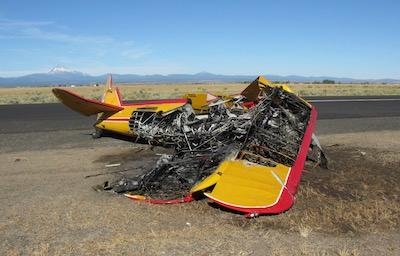Fri, Aug 17, 2018
Cites Pilot Error During Low-Level Maneuver
The NTSB has released its probable cause report from an accident which occurred August 27, 2016 that fatally injured airshow performer Marcus Paine during the Cascades Airshow in Madras in Oregon.

According to the report, Paine was attempting to perform an inside loop immediately after takeoff in his Stearman as part of his performance. He had successfully accomplished the maneuver the previous day, as well as at many previous air shows. Witnesses observed the airplane lift off the runway and remain in a level attitude just above the runway surface before it climbed to perform the loop.
Witnesses reported that the airplane descended from the top of the loop to a point in which its pitch attitude was between 10° and 20° nose-down until it impacted the runway. Video footage of the accident indicated that the pilot was in control of the airplane throughout the maneuver, and postaccident examination revealed no evidence of a preimpact mechanical malfunction or failure that would have precluded normal operation.
Another performer at the airshow reported that, during the evening practice the day before the accident, he observed the pilot perform the same maneuver, and described it as "sketchy" because of the low altitude at which the pilot completed the loop. He added that he previously asked the pilot how to perform this maneuver and the pilot said that it was a "complete crapshoot"; at the top of the loop, the pilot would decide whether he would "pull through and continue the loop or rollout into a half-Cuban or an Immelmann," both of which are recovery aerobatic maneuvers.
Prior to takeoff, the Air Boss reported to the pilot a density altitude (DA) of 4,600 ft. Postaccident calculations revealed that the DA at the time of the accident was about 5,221 ft, both of which are well above a standard day. The high density altitude conditions would have degraded the airplane's overall performance, resulting in decreased engine power available and reduced rate of climb. It is likely that the pilot failed to adequately compensate for the changes in airplane performance due to the high density altitude conditions, which resulted in a collision with terrain.
The NTSB determined the probable cause(s) of this accident to be the pilot's failure to maintain clearance from the runway during a low-level aerobatic maneuver. Contributing to the accident was a high density altitude and the pilot's failure to plan/adequately compensate for high density altitude conditions.
(Image from NTSB accident docket)
More News
Circle To Runway (Runway Number) Used by ATC to inform the pilot that he/she must circle to land because the runway in use is other than the runway aligned with the instrument appr>[...]
Aero Linx: National Aviation Safety Foundation (NASF) The National Aviation Safety Foundation is a support group whose objective is to enhance aviation safety through educational p>[...]
At Altitude Of About 250-300 Ft Agl, The Airplane Experienced A Total Loss Of Engine Power On November 6, 2024, at 1600 central standard time, a De Havilland DHC-1, N420TD, was inv>[...]
From 2009 (YouTube Edition): Three Hour Flight Was 'Flawless' -- At Least, Until Mother Nature Intervened For anyone who loves the aviation business, this was a VERY good day. Afte>[...]
Also: AMA Names Tyler Dobbs, More Falcon 9 Ops, Firefly Launch Unsuccessful, Autonomous F-16s The Air Force has begun ground testing a future uncrewed jet design in a milestone tow>[...]
 ANN's Daily Aero-Term (05.05.25): Circle To Runway (Runway Number)
ANN's Daily Aero-Term (05.05.25): Circle To Runway (Runway Number) ANN's Daily Aero-Linx (05.05.25)
ANN's Daily Aero-Linx (05.05.25) NTSB Prelim: De Havilland DHC-1
NTSB Prelim: De Havilland DHC-1 Classic Aero-TV: The Boeing Dreamliner -- Historic First Flight Coverage
Classic Aero-TV: The Boeing Dreamliner -- Historic First Flight Coverage Airborne-NextGen 05.06.25: AF Uncrewed Fighters, Drones v Planes, Joby Crew Test
Airborne-NextGen 05.06.25: AF Uncrewed Fighters, Drones v Planes, Joby Crew Test



